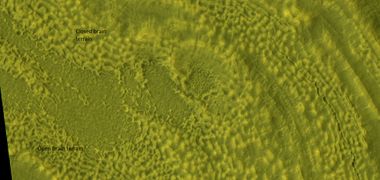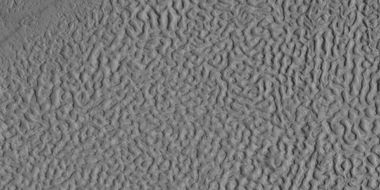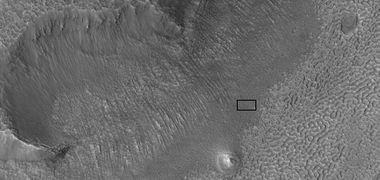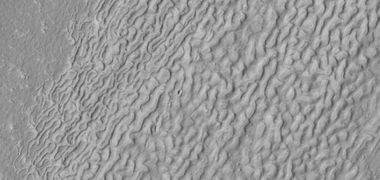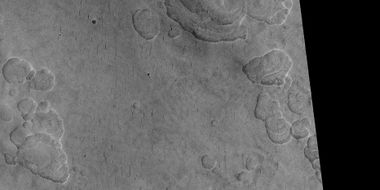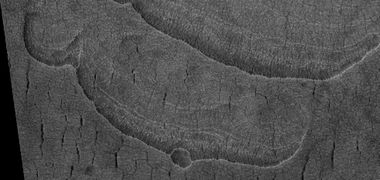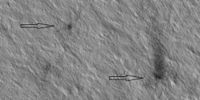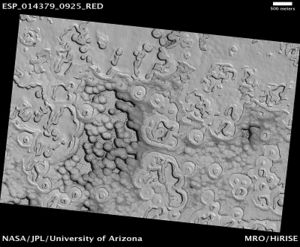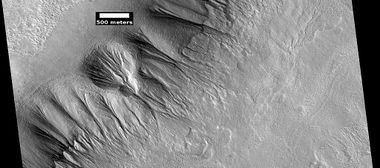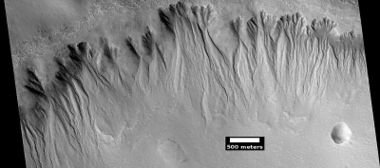Difference between revisions of "Sublimation landscapes on Mars"
m (→Brain Terrain) |
m (→External links) |
||
| (18 intermediate revisions by 2 users not shown) | |||
| Line 1: | Line 1: | ||
| − | Due to the thin atmosphere and extreme cold on Mars, sublimation is very significant in | + | Sublimation is the process where a solid goes directly to a gas. It is easily seen with dry ice on Earth. A chunk of dry ice on the Earth will just disappear without leaving any trace of a liquid. Due to the thin atmosphere and extreme cold on Mars, sublimation is very significant in changing water ice to water vapor. It is believed that much of the ground on Mars contains a great deal of ice. Dust is also present in varying amounts with the ice. |
| − | There is much evidence that the Red Planet once held much water. It probably had streams, rivers, lakes, and perhaps an ocean. | + | There is much evidence that the Red Planet once held much water. It probably had streams, rivers, lakes, and perhaps an ocean. Today, nearly all water ice is frozen at the poles or in the ground. Many areas contain much ice that has been preserved for millions of years beneath a cover of dust and other debris. If cracks occur, ice sublimates along the surface. Any dust remaining will eventually be blown away by the wind. The resulting surface will then display various low spots, cracks, and canyons. |
==Brain Terrain== | ==Brain Terrain== | ||
| − | Today, most of the water has left the planet, but a substantial amount is left frozen the ground and in a material called “latitude dependent mantle.” After cracks form in the frozen ground and mantle, the fun begins. The cracks greatly increase the surface area over which water can sublimate. Water sublimates and leaves behind dust. The dust | + | Today, most of the water has left the planet, but a substantial amount is left frozen the ground and in a material called “latitude dependent mantle.” After cracks form in the frozen ground and mantle, the fun begins. The cracks greatly increase the surface area over which water can sublimate. Water sublimates and leaves behind dust. The dust insulates the ground below from losing more water for a time or, at times the dust can be blown away. This process creates various holes and pits on the surface. |
A common feature in ice-rich ground is “brain terrain.” So named for its resemblance to the human brain. Sublimation is greatly increased along the surface of cracks.<ref> Mangold, N (2003). "Geomorphic analysis of lobate debris aprons on Mars at Mars Orbiter Camera scale: Evidence for ice sublimation initiated by fractures." J. Geophys. Res. 108: 8021. </ref> In time, some broad ridges are left which may still contain some water-ice. The cracks form random patterns So the high and low points are random, thus looking like the outside of our brains. Initially the ridges are wide making what’s called “closed brain terrain;” later when ice leaves the core of the wide ridges, “open brain terrain” results.<ref>Levy, J., J. Head, D. Marchant. 2009. Concentric crater fill in Utopia Planitia: History and interaction between glacial “brain terrain” and periglacial mantle processes. Icarus 202, 462–476.</ref> | A common feature in ice-rich ground is “brain terrain.” So named for its resemblance to the human brain. Sublimation is greatly increased along the surface of cracks.<ref> Mangold, N (2003). "Geomorphic analysis of lobate debris aprons on Mars at Mars Orbiter Camera scale: Evidence for ice sublimation initiated by fractures." J. Geophys. Res. 108: 8021. </ref> In time, some broad ridges are left which may still contain some water-ice. The cracks form random patterns So the high and low points are random, thus looking like the outside of our brains. Initially the ridges are wide making what’s called “closed brain terrain;” later when ice leaves the core of the wide ridges, “open brain terrain” results.<ref>Levy, J., J. Head, D. Marchant. 2009. Concentric crater fill in Utopia Planitia: History and interaction between glacial “brain terrain” and periglacial mantle processes. Icarus 202, 462–476.</ref> | ||
| − | + | ||
| + | <gallery class="center" widths="380px" heights="360px"> | ||
| + | File:53642 2225brains.jpg |Open and closed brain terrain | ||
| + | File:45507 2200brains.jpg |Brain terrain | ||
| + | File:54527 2225brainsface.jpg|Brain Terrain to the right. Box shows the size of a football field. Picture taken with HiRISE, under HiWish program. | ||
| + | File:53630 2195brainslvf.jpg|Close view of brain terrain | ||
| + | </gallery> | ||
==Ribbed Terrain== | ==Ribbed Terrain== | ||
| Line 13: | Line 19: | ||
Sometimes large amounts of ice leave along the cracks and the cracks are bigger, but less in number. Eventually, wide canyons appear. This forms what has been called “ribbed terrain.”<ref> Baker, D., J. Head. 2015. Extensive Middle Amazonian mantling of debris aprons and plains in Deuteronilus Mensae, Mars: Implication for the record of mid-latitude glaciation. Icarus: 260, 269-288.</ref> A wide version of this sometimes forms wide canyons where the ground seems to be hollowed out. These places can be very beautiful. | Sometimes large amounts of ice leave along the cracks and the cracks are bigger, but less in number. Eventually, wide canyons appear. This forms what has been called “ribbed terrain.”<ref> Baker, D., J. Head. 2015. Extensive Middle Amazonian mantling of debris aprons and plains in Deuteronilus Mensae, Mars: Implication for the record of mid-latitude glaciation. Icarus: 260, 269-288.</ref> A wide version of this sometimes forms wide canyons where the ground seems to be hollowed out. These places can be very beautiful. | ||
| − | <gallery class="center" widths=" | + | |
| + | <gallery class="center" widths="380px" heights="360px"> | ||
File:ESP 042554 2245ribbedterrain.jpg|Ribbed terrain Sublimation along narrow cracks cause ribbed terrain with wide troughs to form. | File:ESP 042554 2245ribbedterrain.jpg|Ribbed terrain Sublimation along narrow cracks cause ribbed terrain with wide troughs to form. | ||
| Line 27: | Line 34: | ||
Another form that develops in ice-rich ground, especially in the higher latitudes is what’s called “scalloped terrain.” It looks like material has been scooped out. Usually scalloped depressions have a steeper pole-facing wall and a gentle equator facing slope.<ref>Lefort, A.; Russell, P. S.; Thomas, N.; McEwen, A. S.; Dundas, C. M.; Kirk, R. L. (2009). "Observations of periglacial landforms in Utopia Planitia with the High Resolution Imaging Science Experiment (HiRISE)". Journal of Geophysical Research. 114 (E4)</ref> | Another form that develops in ice-rich ground, especially in the higher latitudes is what’s called “scalloped terrain.” It looks like material has been scooped out. Usually scalloped depressions have a steeper pole-facing wall and a gentle equator facing slope.<ref>Lefort, A.; Russell, P. S.; Thomas, N.; McEwen, A. S.; Dundas, C. M.; Kirk, R. L. (2009). "Observations of periglacial landforms in Utopia Planitia with the High Resolution Imaging Science Experiment (HiRISE)". Journal of Geophysical Research. 114 (E4)</ref> | ||
| − | + | ||
| + | <gallery class="center" widths="380px" heights="360px"> | ||
| + | |||
| + | File:44042 2240scallopedterrain.jpg |thumb|200px|center|Scalloped terrain The steep wall faces the north pole. Studies from orbit have shown the presence of ice in these formations. | ||
| + | |||
| + | File:53496 2245scallopsclose.jpg|Close view of Scalloped terrain in the Casius quadrangle The steep wall faces the north pole. Studies from orbit have shown the presence of ice in these formations. | ||
| + | |||
| + | </gallery> | ||
| + | |||
| + | |||
==Seasonal Changes== | ==Seasonal Changes== | ||
| Line 35: | Line 51: | ||
==Spiders== | ==Spiders== | ||
| − | In places at the southern pole, a thick slab of transparent dry ice covers the ground. With the arrival of higher sunlight levels, much sublimation occurs under the slab and builds up pressure. When cracks appear in weak areas, the gas rushes out at high speeds carrying black dust with it. Speeds may be up to 100 miles per hour.<ref name="themis.asu.edu">http://themis.asu.edu/news/gas-jets-spawn-dark-spiders-and-spots-mars-icecap</ref> These events can resemble terrestrial geysers. Often surface winds spread the black dust into a fan shaped plume. Under the ice, channels frequently form which looks like a spider, so they are named “spiders.” | + | In places at the southern pole, a thick slab of transparent dry ice covers the ground.<ref>Portyankina, G., et al. 2018. Laboratory investigations of the physical state of CO2 ice in a simulated Martian environment. Icarus</ref> With the arrival of higher sunlight levels, much sublimation occurs under the slab and builds up pressure. When cracks appear in weak areas, the gas rushes out at high speeds carrying black dust with it. Speeds may be up to 100 miles per hour.<ref name="themis.asu.edu">http://themis.asu.edu/news/gas-jets-spawn-dark-spiders-and-spots-mars-icecap</ref> These events can resemble terrestrial geysers. Often surface winds spread the black dust into a fan shaped plume. Under the ice, channels frequently form which looks like a spider, so they are named “spiders.” |
[[File:47609 0985spiderlongclose.jpg |thumb|200px|center|Spiders indicated with arrows. The plume on the right was caused by wind blowing from the bottom to the top of the image.]] | [[File:47609 0985spiderlongclose.jpg |thumb|200px|center|Spiders indicated with arrows. The plume on the right was caused by wind blowing from the bottom to the top of the image.]] | ||
| Line 43: | Line 59: | ||
Also, in the southern area, “Swiss Cheese Terrain” develops. Pits form in a 1-10 meter thick layer of dry ice. They get larger and larger in are until the surface looks like Swiss cheese. They start along small fractures.<ref> Thomas,P., M. Malin, P. James, B. Cantor, R. Williams, P. Gierasch South polar residual cap of Mars: features, stratigraphy, and changes Icarus, 174 (2 SPEC. ISS.). 2005. pp. 535–559. http://doi.org/10.1016/j.icarus.2004.07.028</ref> <ref>Thomas, P., P. James, W. Calvin, R. Haberle, M. Malin. 2009. Residual south polar cap of Mars: stratigraphy, history, and implications of recent changes Icarus: 203, 352–375 http://doi.org/10.1016/j.icarus.2009.05.014 </ref> <ref> Thomas, P., W.Calvin, P. Gierasch, R. Haberle, P. James, S. Sholes. 2013. Time scales of erosion and deposition recorded in the residual south polar cap of mars Icarus: 225: 923–932 http://doi.org/10.1016/j.icarus.2012.08.038</ref> <ref>Thomas, P., W. Calvin, B. Cantor, R. Haberle, P. James, S. Lee. 2016. Mass balance of Mars’ residual south polar cap from CTX images and other data Icarus: 268, 118–130 http://doi.org/10.1016/j.icarus.2015.12.03 </ref> <ref>Buhler, Peter, Andrew Ingersoll, Bethany Ehlmann, Caleb Fassett, James Head. 2017. How the martian residual south polar cap develops quasi-circular and heart-shaped pits, troughs, and moats. Icarus: 286, 69-9.</ref> | Also, in the southern area, “Swiss Cheese Terrain” develops. Pits form in a 1-10 meter thick layer of dry ice. They get larger and larger in are until the surface looks like Swiss cheese. They start along small fractures.<ref> Thomas,P., M. Malin, P. James, B. Cantor, R. Williams, P. Gierasch South polar residual cap of Mars: features, stratigraphy, and changes Icarus, 174 (2 SPEC. ISS.). 2005. pp. 535–559. http://doi.org/10.1016/j.icarus.2004.07.028</ref> <ref>Thomas, P., P. James, W. Calvin, R. Haberle, M. Malin. 2009. Residual south polar cap of Mars: stratigraphy, history, and implications of recent changes Icarus: 203, 352–375 http://doi.org/10.1016/j.icarus.2009.05.014 </ref> <ref> Thomas, P., W.Calvin, P. Gierasch, R. Haberle, P. James, S. Sholes. 2013. Time scales of erosion and deposition recorded in the residual south polar cap of mars Icarus: 225: 923–932 http://doi.org/10.1016/j.icarus.2012.08.038</ref> <ref>Thomas, P., W. Calvin, B. Cantor, R. Haberle, P. James, S. Lee. 2016. Mass balance of Mars’ residual south polar cap from CTX images and other data Icarus: 268, 118–130 http://doi.org/10.1016/j.icarus.2015.12.03 </ref> <ref>Buhler, Peter, Andrew Ingersoll, Bethany Ehlmann, Caleb Fassett, James Head. 2017. How the martian residual south polar cap develops quasi-circular and heart-shaped pits, troughs, and moats. Icarus: 286, 69-9.</ref> | ||
| − | [[File:South Pole Terrain.jpg | | + | [[File:South Pole Terrain.jpg |center|thumb|px| Swiss cheese terrain, as seen by HiRISE]] |
==Gullies== | ==Gullies== | ||
| − | In mid-latitudes, gullies are common in large areas in both the northern and southern hemisphere. They occur on steep slopes like crater walls.<ref> Malin, M.; Edgett, K. (2000). "Evidence for recent groundwater seepage and surface runoff on Mars". Science. 288: 2330–2335</ref> <ref> Edgett, K.; et al. (2003). "Polar-and middle-latitude martian gullies: A view from MGS MOC after 2 Mars years in the mapping orbit" (PDF). Lunar Planet. Sci. 34. Abstract 1038.</ref> For many years, they were thought to be caused by running water. However, closer examination over a period of years revealed that some are growing under present conditions where liquid water is not possible.<ref>https://scitechdaily.com/linear-gullies-on-mars-caused-by-sliding-dry-ice</ref> Experiments on Earth demonstrated that chunks of dry ice moving down slopes could create gullies with a similar appearance. So, at least some of the gullies are being formed by dry ice building up in the winter and then causing erosion as they slide downhill in the warm spring.<ref>http://www.psrd.hawaii.edu/Aug03/MartianGullies.html</ref> <ref>Diniega, S.; Byrne, S.; Bridges, N. T.; Dundas, C. M.; McEwen, A. S. (2010). "Seasonality of present-day Martian dune-gully activity". Geology. 38: 1047–1050.</ref> <ref>NASA/Jet Propulsion Laboratory. "Study links fresh Mars gullies to carbon dioxide." ScienceDaily 30 October 2010. 10 March 2011</ref> This process is aided by carbon dioxide vapor jetting off the dry ice and lifting it a bit.<ref>https://www.nasa.gov/home/hqnews/2013/jun/HQ_13-180_Mars_Dry_Ice_Gullies.html#.WXDOT4WcGUk</ref> Note that present growth of gullies happens just as the temperature rises to where dry ice can easily sublimate. | + | In mid-latitudes, gullies are common in large areas in both the northern and southern hemisphere. They occur on steep slopes like crater walls.<ref> Malin, M.; Edgett, K. (2000). "Evidence for recent groundwater seepage and surface runoff on Mars". Science. 288: 2330–2335</ref> <ref> Edgett, K.; et al. (2003). "Polar-and middle-latitude martian gullies: A view from MGS MOC after 2 Mars years in the mapping orbit" (PDF). Lunar Planet. Sci. 34. Abstract 1038.</ref> For many years, they were thought to be caused by running water. However, closer examination over a period of years, revealed that some are growing under present conditions where liquid water is not possible.<ref>https://scitechdaily.com/linear-gullies-on-mars-caused-by-sliding-dry-ice</ref> Experiments on Earth demonstrated that chunks of dry ice moving down slopes could create gullies with a similar appearance. So, at least some of the gullies are being formed by dry ice building up in the winter and then causing erosion as they slide downhill in the warm spring.<ref>http://www.psrd.hawaii.edu/Aug03/MartianGullies.html</ref> <ref>Diniega, S.; Byrne, S.; Bridges, N. T.; Dundas, C. M.; McEwen, A. S. (2010). "Seasonality of present-day Martian dune-gully activity". Geology. 38: 1047–1050.</ref> <ref>NASA/Jet Propulsion Laboratory. "Study links fresh Mars gullies to carbon dioxide." ScienceDaily 30 October 2010. 10 March 2011</ref> This process is aided by carbon dioxide vapor jetting off the dry ice and lifting it a bit.<ref>https://www.nasa.gov/home/hqnews/2013/jun/HQ_13-180_Mars_Dry_Ice_Gullies.html#.WXDOT4WcGUk</ref> Note that present growth of gullies happens just as the temperature rises to where dry ice can easily sublimate. |
| + | |||
| − | + | <gallery class="center" widths="380px" heights="360px"> | |
| + | File:ESP 044707 2285gullies.jpg|Gullies along mesa wall in Arcadia quadrangle | ||
| + | File:ESP 037506 2285gullychannels.jpg|Gullies along a steep slope | ||
| + | </gallery> | ||
==See also== | ==See also== | ||
| + | |||
| + | *[[High Resolution Imaging Science Experiment (HiRISE)]] | ||
*[[Martian features that are signs of water ice]] | *[[Martian features that are signs of water ice]] | ||
*[[ What Mars Actually Looks Like!]] | *[[ What Mars Actually Looks Like!]] | ||
| Line 57: | Line 79: | ||
==References== | ==References== | ||
| + | |||
{{Reflist|colwidth=30em}} | {{Reflist|colwidth=30em}} | ||
==External links== | ==External links== | ||
| − | |||
| − | |||
| − | |||
| − | |||
| − | [[ | + | *[https://www.youtube.com/watch?v=ZNTNzQy1_UA Walks on Mars - Jim Secosky - 16th Annual International Mars Society Convention] |
| − | [[ | + | *[https://www.youtube.com/watch?v=_sUUKcZaTgA Jim Secosky - Martian Ice - 16th Annual International Mars Society Convention] |
| + | * [https://www.youtube.com/watch?v=mNXBfz1iVzc Video demonstrates how dry ice can form gullies on dunes] | ||
| + | *[https://www.youtube.com/watch?v=B1UU8XSMHmM Pictures of gullies on dunes] | ||
| + | *[https://www.youtube.com/watch?v=jZpJqlzCRpw Demonstration of dry ice moving down dunes ] | ||
| + | |||
| + | |||
| + | [[Category:Topography]] | ||
Revision as of 05:50, 23 March 2020
Sublimation is the process where a solid goes directly to a gas. It is easily seen with dry ice on Earth. A chunk of dry ice on the Earth will just disappear without leaving any trace of a liquid. Due to the thin atmosphere and extreme cold on Mars, sublimation is very significant in changing water ice to water vapor. It is believed that much of the ground on Mars contains a great deal of ice. Dust is also present in varying amounts with the ice. There is much evidence that the Red Planet once held much water. It probably had streams, rivers, lakes, and perhaps an ocean. Today, nearly all water ice is frozen at the poles or in the ground. Many areas contain much ice that has been preserved for millions of years beneath a cover of dust and other debris. If cracks occur, ice sublimates along the surface. Any dust remaining will eventually be blown away by the wind. The resulting surface will then display various low spots, cracks, and canyons.
Contents
Brain Terrain
Today, most of the water has left the planet, but a substantial amount is left frozen the ground and in a material called “latitude dependent mantle.” After cracks form in the frozen ground and mantle, the fun begins. The cracks greatly increase the surface area over which water can sublimate. Water sublimates and leaves behind dust. The dust insulates the ground below from losing more water for a time or, at times the dust can be blown away. This process creates various holes and pits on the surface. A common feature in ice-rich ground is “brain terrain.” So named for its resemblance to the human brain. Sublimation is greatly increased along the surface of cracks.[1] In time, some broad ridges are left which may still contain some water-ice. The cracks form random patterns So the high and low points are random, thus looking like the outside of our brains. Initially the ridges are wide making what’s called “closed brain terrain;” later when ice leaves the core of the wide ridges, “open brain terrain” results.[2]
Ribbed Terrain
Sometimes large amounts of ice leave along the cracks and the cracks are bigger, but less in number. Eventually, wide canyons appear. This forms what has been called “ribbed terrain.”[3] A wide version of this sometimes forms wide canyons where the ground seems to be hollowed out. These places can be very beautiful.
Scalloped Terrain
Another form that develops in ice-rich ground, especially in the higher latitudes is what’s called “scalloped terrain.” It looks like material has been scooped out. Usually scalloped depressions have a steeper pole-facing wall and a gentle equator facing slope.[4]
Seasonal Changes
During the Martian winter dry ice is deposited at the winter pole. During the Martian summer carbon dioxide ice sublimes from the summer pole. The amount that is deposited and then sublimated in the spring is huge—indeed at least 12-16 % of the atmosphere is deposited and removed each Martian year.[5] [6] This process causes great pressure changes and high winds.
Spiders
In places at the southern pole, a thick slab of transparent dry ice covers the ground.[7] With the arrival of higher sunlight levels, much sublimation occurs under the slab and builds up pressure. When cracks appear in weak areas, the gas rushes out at high speeds carrying black dust with it. Speeds may be up to 100 miles per hour.[8] These events can resemble terrestrial geysers. Often surface winds spread the black dust into a fan shaped plume. Under the ice, channels frequently form which looks like a spider, so they are named “spiders.”
Swiss Cheese Terrain
Also, in the southern area, “Swiss Cheese Terrain” develops. Pits form in a 1-10 meter thick layer of dry ice. They get larger and larger in are until the surface looks like Swiss cheese. They start along small fractures.[9] [10] [11] [12] [13]
Gullies
In mid-latitudes, gullies are common in large areas in both the northern and southern hemisphere. They occur on steep slopes like crater walls.[14] [15] For many years, they were thought to be caused by running water. However, closer examination over a period of years, revealed that some are growing under present conditions where liquid water is not possible.[16] Experiments on Earth demonstrated that chunks of dry ice moving down slopes could create gullies with a similar appearance. So, at least some of the gullies are being formed by dry ice building up in the winter and then causing erosion as they slide downhill in the warm spring.[17] [18] [19] This process is aided by carbon dioxide vapor jetting off the dry ice and lifting it a bit.[20] Note that present growth of gullies happens just as the temperature rises to where dry ice can easily sublimate.
See also
- High Resolution Imaging Science Experiment (HiRISE)
- Martian features that are signs of water ice
- What Mars Actually Looks Like!
- Sublimation
References
- ↑ Mangold, N (2003). "Geomorphic analysis of lobate debris aprons on Mars at Mars Orbiter Camera scale: Evidence for ice sublimation initiated by fractures." J. Geophys. Res. 108: 8021.
- ↑ Levy, J., J. Head, D. Marchant. 2009. Concentric crater fill in Utopia Planitia: History and interaction between glacial “brain terrain” and periglacial mantle processes. Icarus 202, 462–476.
- ↑ Baker, D., J. Head. 2015. Extensive Middle Amazonian mantling of debris aprons and plains in Deuteronilus Mensae, Mars: Implication for the record of mid-latitude glaciation. Icarus: 260, 269-288.
- ↑ Lefort, A.; Russell, P. S.; Thomas, N.; McEwen, A. S.; Dundas, C. M.; Kirk, R. L. (2009). "Observations of periglacial landforms in Utopia Planitia with the High Resolution Imaging Science Experiment (HiRISE)". Journal of Geophysical Research. 114 (E4)
- ↑ Antonio Genova, Sander Goossens, Frank G. Lemoine, Erwan Mazarico, Gregory A. Neumann, David E. Smith, Maria T. Zuber. Seasonal and static gravity field of Mars from MGS, Mars Odyssey and MRO radio science. Icarus, 2016; 272: 228 DOI: 10.1016/j.icarus.2016.02.05
- ↑ NASA/Goddard Space Flight Center. "New gravity map gives best view yet inside Mars." ScienceDaily. ScienceDaily, 21 March 2016.
- ↑ Portyankina, G., et al. 2018. Laboratory investigations of the physical state of CO2 ice in a simulated Martian environment. Icarus
- ↑ http://themis.asu.edu/news/gas-jets-spawn-dark-spiders-and-spots-mars-icecap
- ↑ Thomas,P., M. Malin, P. James, B. Cantor, R. Williams, P. Gierasch South polar residual cap of Mars: features, stratigraphy, and changes Icarus, 174 (2 SPEC. ISS.). 2005. pp. 535–559. http://doi.org/10.1016/j.icarus.2004.07.028
- ↑ Thomas, P., P. James, W. Calvin, R. Haberle, M. Malin. 2009. Residual south polar cap of Mars: stratigraphy, history, and implications of recent changes Icarus: 203, 352–375 http://doi.org/10.1016/j.icarus.2009.05.014
- ↑ Thomas, P., W.Calvin, P. Gierasch, R. Haberle, P. James, S. Sholes. 2013. Time scales of erosion and deposition recorded in the residual south polar cap of mars Icarus: 225: 923–932 http://doi.org/10.1016/j.icarus.2012.08.038
- ↑ Thomas, P., W. Calvin, B. Cantor, R. Haberle, P. James, S. Lee. 2016. Mass balance of Mars’ residual south polar cap from CTX images and other data Icarus: 268, 118–130 http://doi.org/10.1016/j.icarus.2015.12.03
- ↑ Buhler, Peter, Andrew Ingersoll, Bethany Ehlmann, Caleb Fassett, James Head. 2017. How the martian residual south polar cap develops quasi-circular and heart-shaped pits, troughs, and moats. Icarus: 286, 69-9.
- ↑ Malin, M.; Edgett, K. (2000). "Evidence for recent groundwater seepage and surface runoff on Mars". Science. 288: 2330–2335
- ↑ Edgett, K.; et al. (2003). "Polar-and middle-latitude martian gullies: A view from MGS MOC after 2 Mars years in the mapping orbit" (PDF). Lunar Planet. Sci. 34. Abstract 1038.
- ↑ https://scitechdaily.com/linear-gullies-on-mars-caused-by-sliding-dry-ice
- ↑ http://www.psrd.hawaii.edu/Aug03/MartianGullies.html
- ↑ Diniega, S.; Byrne, S.; Bridges, N. T.; Dundas, C. M.; McEwen, A. S. (2010). "Seasonality of present-day Martian dune-gully activity". Geology. 38: 1047–1050.
- ↑ NASA/Jet Propulsion Laboratory. "Study links fresh Mars gullies to carbon dioxide." ScienceDaily 30 October 2010. 10 March 2011
- ↑ https://www.nasa.gov/home/hqnews/2013/jun/HQ_13-180_Mars_Dry_Ice_Gullies.html#.WXDOT4WcGUk
